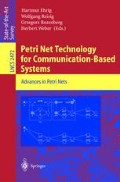Abstract
The VIP1 approach [8,7] aims at modeling and validating process specifications with High-level Petri nets in different application domains. It is based on simulative creation of partially ordered runs and employs advantages of these semantics with respect to efficiency and expressive power compared to sequential simulation. This contribution presents a new component to the VIP architecture, namely VIPbusiness. This component allows to apply the VIP approach and the corresponding VIPtool for the creation, validation and quantitative analysis of business process specifications. The approach aims at supporting early phases of projects where business processes and information systems have to be integrated.
Access this chapter
Tax calculation will be finalised at checkout
Purchases are for personal use only
Preview
Unable to display preview. Download preview PDF.
References
van der Aalst, W.M.P.: Three Good Reasons for Using a Petri-Net-Based Workflow Management System. In: Wakayama, T., et al. (eds.) Information and Process Integration in Enterprises: Rethinking Documents. The Kluwer International Series in Engineering and Computer Science, ch. 10, pp. 161–182. Kluwer Academic Publishers, Norwell (1998)
van der Aalst, W.M.P.: The Application of Petri Nets to Workflow Management. The Journal of Circuits, Systems and Computers 8(1), 21–66 (1998)
Ajmone, M.M., Bobbio, A., Donatelli, S.: Petri Nets in Performance Analysis: An Introduction. In: Reisig, W., Rozenberg, G. (eds.) APN 1998. LNCS, vol. 1491, pp. 211–256. Springer, Heidelberg (1998)
Buzacott, J.A.: Commonalities in Reengineerd Business Processes: Models and Issues. Management Science 42(5), 768–782 (1996)
Davenport, T.H.: Process Innovation: Reengineering Work Through Information Technology. Harvard Business School Press, Boston (1993)
Desel, J., Erwin, T.: Hybrid Specifications - Looking at Workflows from a Run-Time Perspective. International Journal of Computer Systems Science & Engineering 15(5), 291–302 (2000)
Desel, J., Erwin, T.: Modeling, Simulation and Analysis of Business Processes. In: van der Aalst, W.M.P., Desel, J., Oberweis, A. (eds.) Business Process Management. LNCS, vol. 1806, pp. 129–141. Springer, Heidelberg (2000)
Desel, J.: Validation of Process Models by Construction of Process Nets. In: van der Aalst, W.M.P., Desel, J., Oberweis, A. (eds.) Business Process Management. LNCS, vol. 1806, pp. 110–128. Springer, Heidelberg (2000)
Desel, J., Juhas, C.: What is a Petri Net? In: Ehrig, H., Juhás, G., Padberg, J., Rozenberg, G. (eds.) APN 2001. LNCS, vol. 2128, pp. 1–25. Springer, Heidelberg (2001)
Erwin, T.: Leistungsbewertung von Geschäftsprozessen durch Auswertung halbge-ordneter Petrinetz-Abläufe. Diplomarbeit. Universität Karlsruhe (1998)
Preytag, T.: Softwarevalidierung durch Auswertung von Petrinetz-Abläufen. Dissertation. Universität Karlsruhe (2001)
Genrich, H.J.: Predicate/Transition-Nets. In: Brauer, W., Reisig, W., Rozenberg, G. (eds.) APN 1986. LNCS, vol. 254, pp. 207–247. Springer, Heidelberg (1987)
Gruhn, V., Kampmann, M.: Modellierung unternehmensübergreifender Geschäfts-prozesse mit FUNSOFT-Netzen. Wirtschaftsinformatik 38, 369–381 (1996)
Hammer, M., Champy, J.: Reengineering the Corporation. Nicolas Brealey Publishing, London (1993)
Jablonski, S., Bussler, C.: Workflow Management: Modeling Concepts, Architecture, and Implementation. International Thomson Computer Press, Bonn Albany (1996)
Jensen, K.: Coloured Petri Nets. Analysis Methods. EATCS Monographs on Theoretical Computer Science, vol. 2. Springer, Heidelberg (1995)
Jensen, K.: Coloured Petri Nets. Basic Concepts. EATCS Monographs on Theoretical Computer Science, vol. 1. Springer, Heidelberg (1996)
Johansson, H.J., McHugh, P., Pendlebury, A.J., Wheeler, W.A.: Business Process Reengineering: Breakpoint Strategies for Market Dominance. John Wiley and Sons, New York (1993)
Khoshanfian an, S., Buckiewicz, M.: Introduction to Groupware, Workflow and Workgroup Computing. John Wiley and Sons, New York (1995)
Koulopoulos, T.M.: The Workflow Imperative. Van Nostrand Reinhold, New York (1995)
Lawrence, P. (ed.): Workflow Handbook 1997, Workflow Management Coalition. John Wiley and Sons, New York (1997)
Manganelli, R.L., Klein, M.K.: The Reengineering Handbook: A Step-By-Step Guide to Business Transformation. Amacom, New York (1996)
Morris, D., Brandon, J.: Reengineering Your Business. McGraw-Hill, New York (1993)
Oberweis, A.: Modellierung und Ausführung von Workflows mit Petri-Netzen. Reihe Wirtschaftsinformatik. Teubner, Stuttgart Leipzig (1996)
Poyssick, G., Hannaford, S.: Workflow Reenigineering. Adobe Press, Mountain View (1996)
Reisig, W.: Petri Nets: An Introduction, Monographs in Theoretical Computer Science: an EATCS Series, vol. 4. Springer, Heidelberg (1985)
Scheer, A.W.: Business Process Engineering, Reference Models for Industrial Enterprises. Springer, Heidelberg (1994)
Starke, P.: Analyse von Petri-Netz-Modellen. Leitfäden und Monographien der In-formatik. Teubner, Stuttgart Leipzig (1990)
Author information
Authors and Affiliations
Editor information
Editors and Affiliations
Rights and permissions
Copyright information
© 2003 Springer-Verlag Berlin Heidelberg
About this chapter
Cite this chapter
Desel, J., Erwin, T. (2003). Quantitative Engineering of Business Processes with VIPbusiness . In: Ehrig, H., Reisig, W., Rozenberg, G., Weber, H. (eds) Petri Net Technology for Communication-Based Systems. Lecture Notes in Computer Science, vol 2472. Springer, Berlin, Heidelberg. https://doi.org/10.1007/978-3-540-40022-6_11
Download citation
DOI: https://doi.org/10.1007/978-3-540-40022-6_11
Publisher Name: Springer, Berlin, Heidelberg
Print ISBN: 978-3-540-20538-8
Online ISBN: 978-3-540-40022-6
eBook Packages: Springer Book Archive

